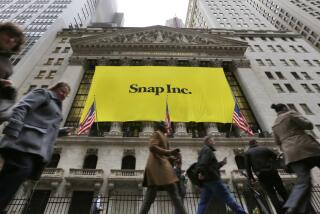Matchmaker for Marriages of Technology and Art
- Share via
Take the brainy science and engineering students from Caltech, mix in some super-creative enrollees from the nearby Art Center College of Design, add a few business students from local universities, and what do you get? A cluster of high-tech start-up companies.
At least that’s what Dave Chan is hoping. Chan, a longtime member of Caltech’s professional staff, left his job developing computer technology for the school’s biology division last year to found First Ascent, a cross between a small- business incubator and a matchmaking service.
“From a conceptual point of view, it’s very interesting,” said Larry Gilbert, director of the Office of Technology Transfer at Caltech. “What they need is a couple of interesting examples of how they’ve put people together and created something greater than the number of parts. I’m sure it’s doable.”
In the year and a half since he launched First Ascent, Chan has attracted the interest of people at Caltech and the art center. He spends most of his time meeting students on the two Pasadena campuses, explaining his vision and arranging artists and scientists in compatible groups.
The schools are separated by only 6 miles, but they are worlds apart culturally.
“It’s not like you can just bring them together and put them in a room and expect things to happen,” Chan said. “You have to spend time with students and nurture those relationships.”
About 15 students are planning companies with First Ascent’s assistance, and a handful of projects are beginning to coalesce.
One is Tooned In, a computer graphics firm that has developed technology to blend two-dimensional animated characters into three-dimensional backgrounds.
Cindy Ball, a Caltech graduate student who will receive a master’s degree in computer science next month, founded Tooned In with two partners in 1994 but left it on the back burner while she finished her degree. She is looking to get the company off the ground this summer.
“We’d gotten some things started, but if we want to take the next step and see where this can go, we need to start developing other business relationships,” said Ball, who worked at Hanna-Barbera before enrolling at Caltech. “We need to know how to raise money, how to approach the market, how to approach clients. There are a lot of details that we hadn’t really addressed seriously yet.”
Recent art center grad Lucian Tu is also relying on help from First Ascent to turn his senior project--a modular electric guitar system with interchangeable parts--into a company. Chan helped Tu find electronics expertise at Caltech, and he even secured a few hundred dollars to help pay the cost of developing a prototype, Tu said.
Now that he has landed a full-time job as an industrial designer in the product development group of IN Inc. in Los Alamitos, Tu is ready to use his spare time on commercializing his Freedom-Tech Guitar System. He plans to use First Ascent for help in filing a patent.
“They can provide the missing links that would be necessary to start a venture,” Tu said.
Bringing engineers and designers together in the early stages of product development should help both groups of students develop more practical and marketable products, said Ted Shida, who works on corporate-sponsored programs at Art Center and has funneled students to First Ascent.
Eventually, Chan hopes to involve business students from USC, UCLA, Pepperdine and Claremont Graduate University. Art Center College of Design has coordinated some projects with the USC Marshall School of Business, and Shida has briefed a Marshall professor about First Ascent. The professor has expressed interest in the project, and Marshall students could become involved by the end of the year, Shida said.
*
First Ascent is also building connections with corporate and patent lawyers and venture capitalists so it can make referrals for students, Chan said.
Chan has spent thousands of his own dollars to launch First Ascent, to which he now devotes most of his time (although he earns most of his income from consulting and personal investments). Ultimately, First Ascent hopes to become profitable by taking equity positions in the firms it helps create.
At the very least, First Ascent could be useful in helping students flesh out ideas that could be turned into products, if not companies, said Caltech’s Gilbert.
“It’s not a bad marriage if it works,” he said.
The collaboration between students from Caltech and Art Center also provides some crucial training for the real world.
“Today, almost every business needs to work on a highly collaborative basis to be competitive,” Shida said.
*
Times staff writer Karen Kaplan can be reached at karen.kaplan @latimes.com.
More to Read
Inside the business of entertainment
The Wide Shot brings you news, analysis and insights on everything from streaming wars to production — and what it all means for the future.
You may occasionally receive promotional content from the Los Angeles Times.











